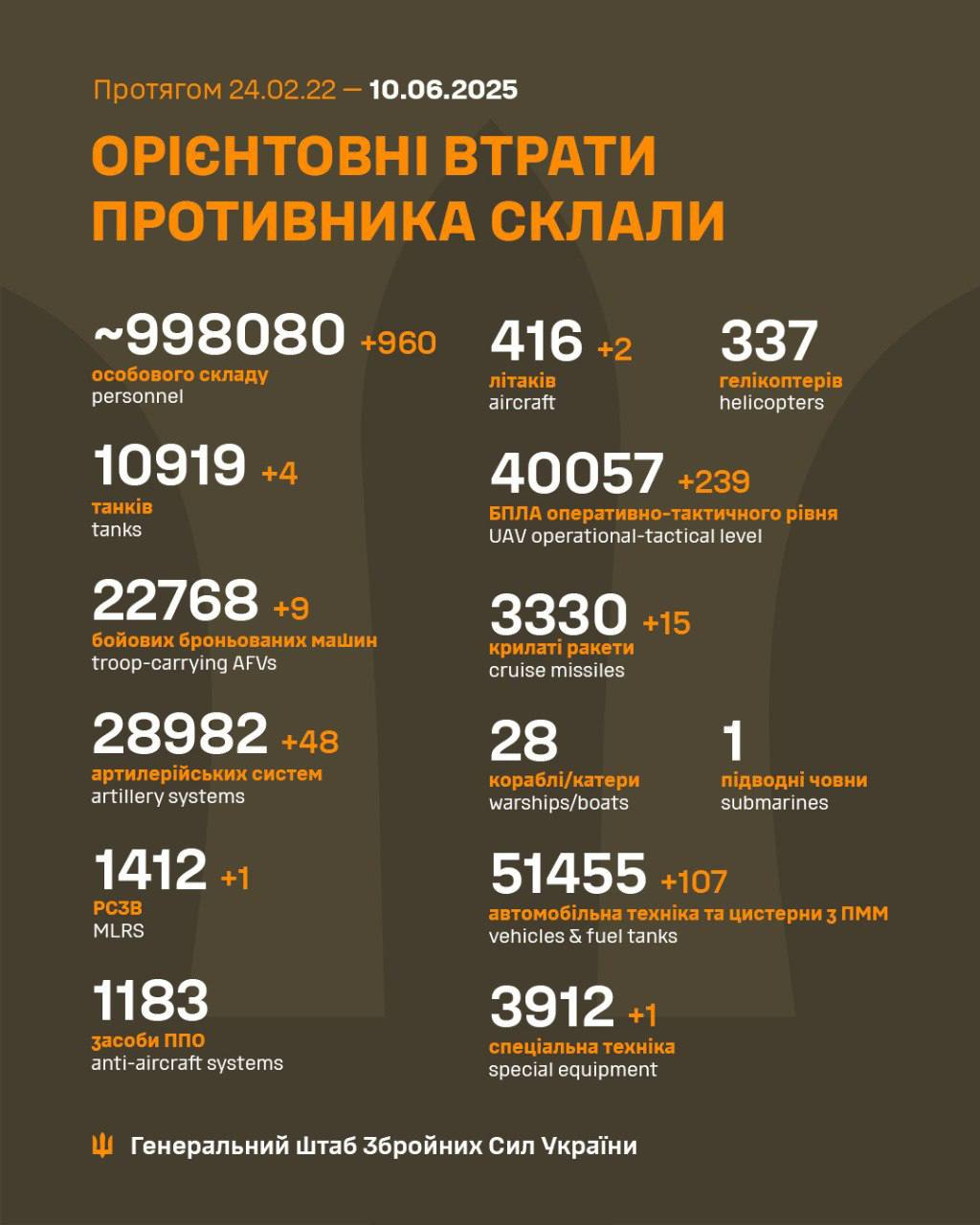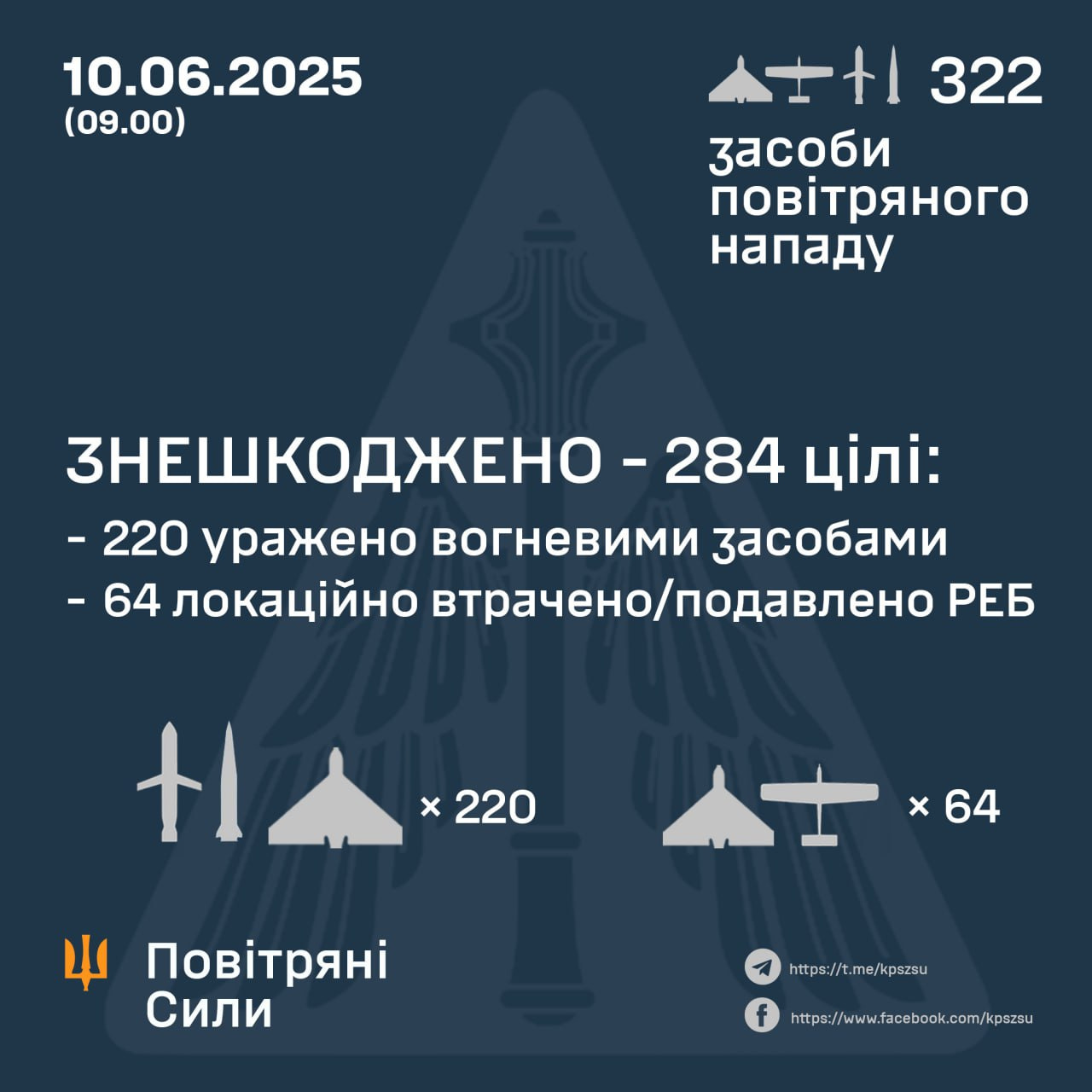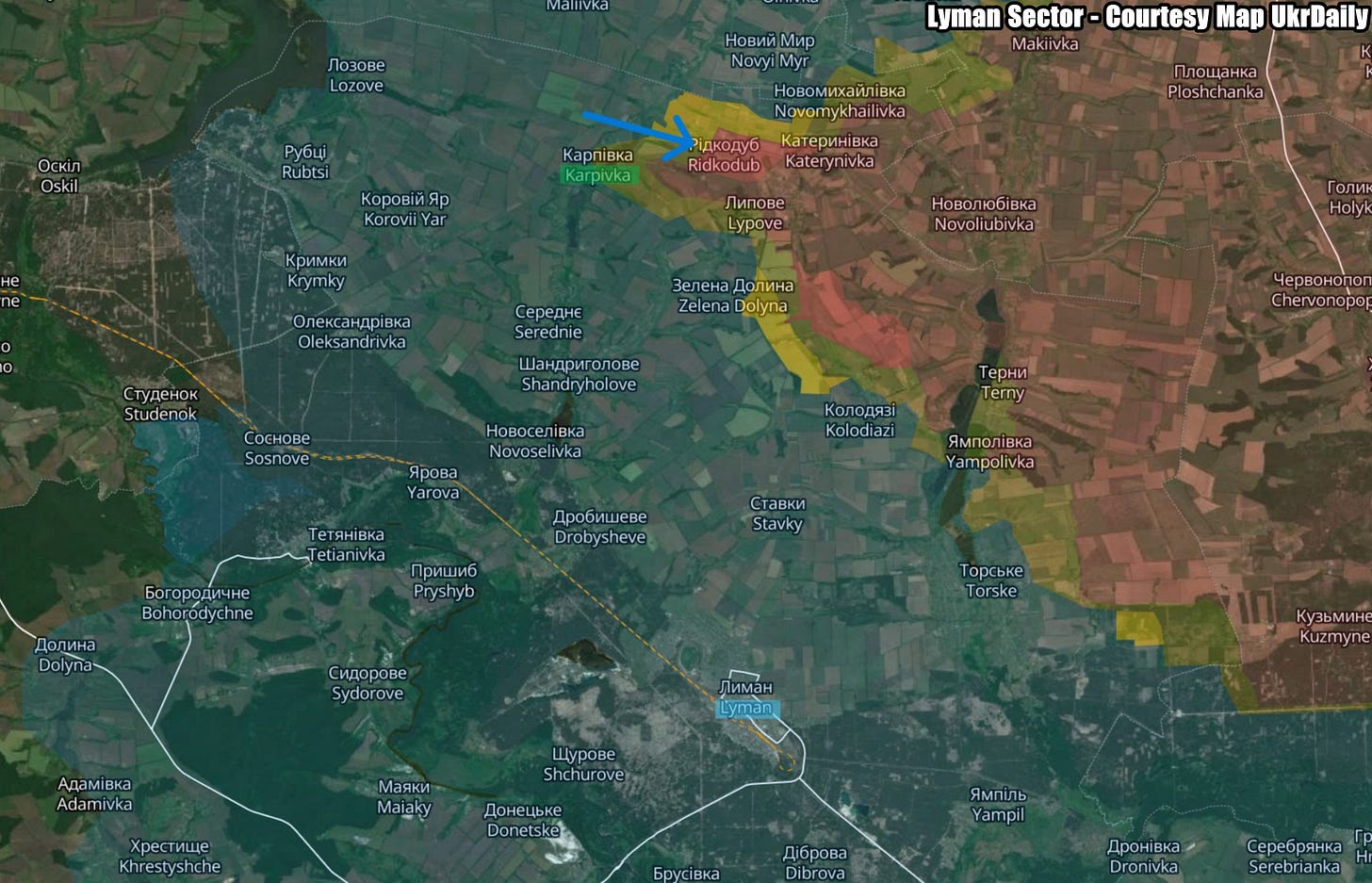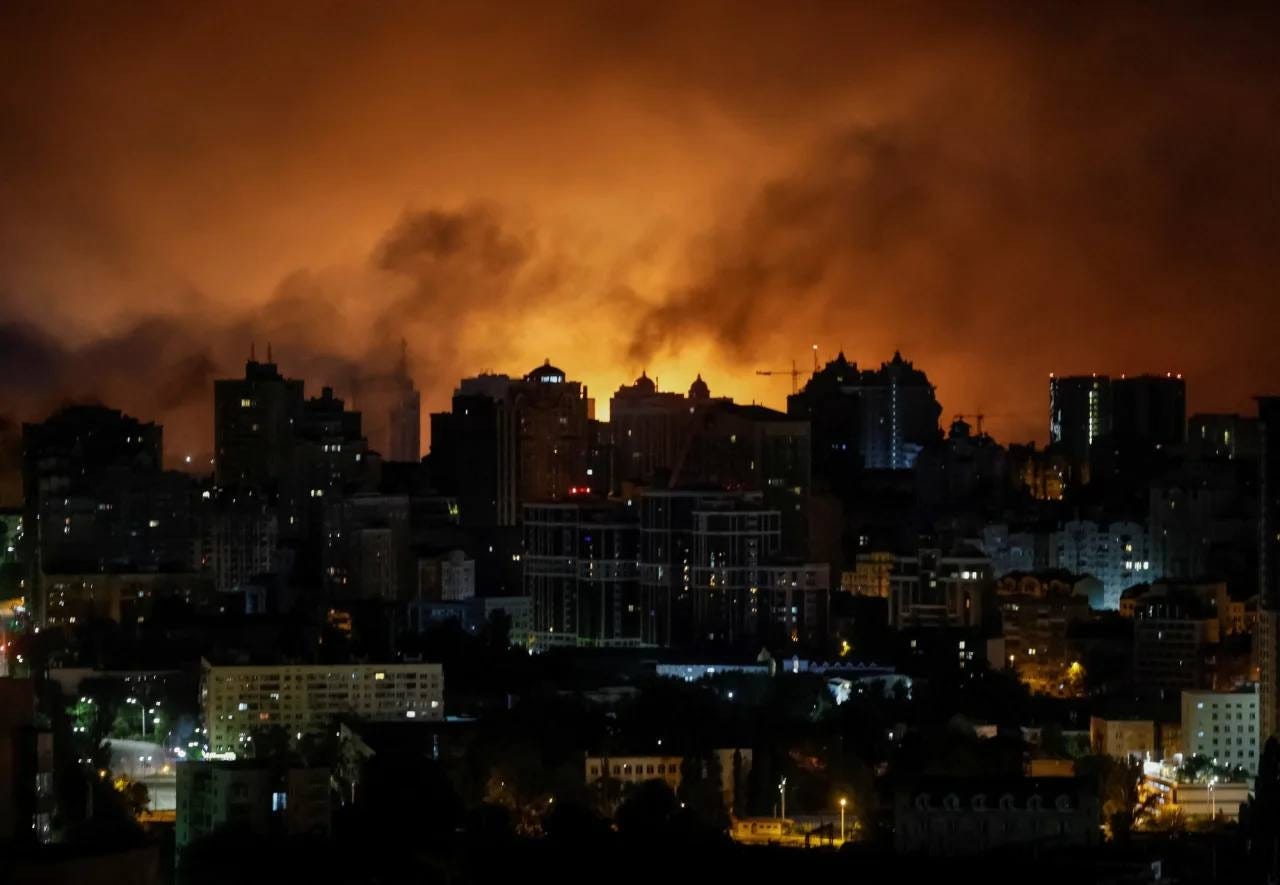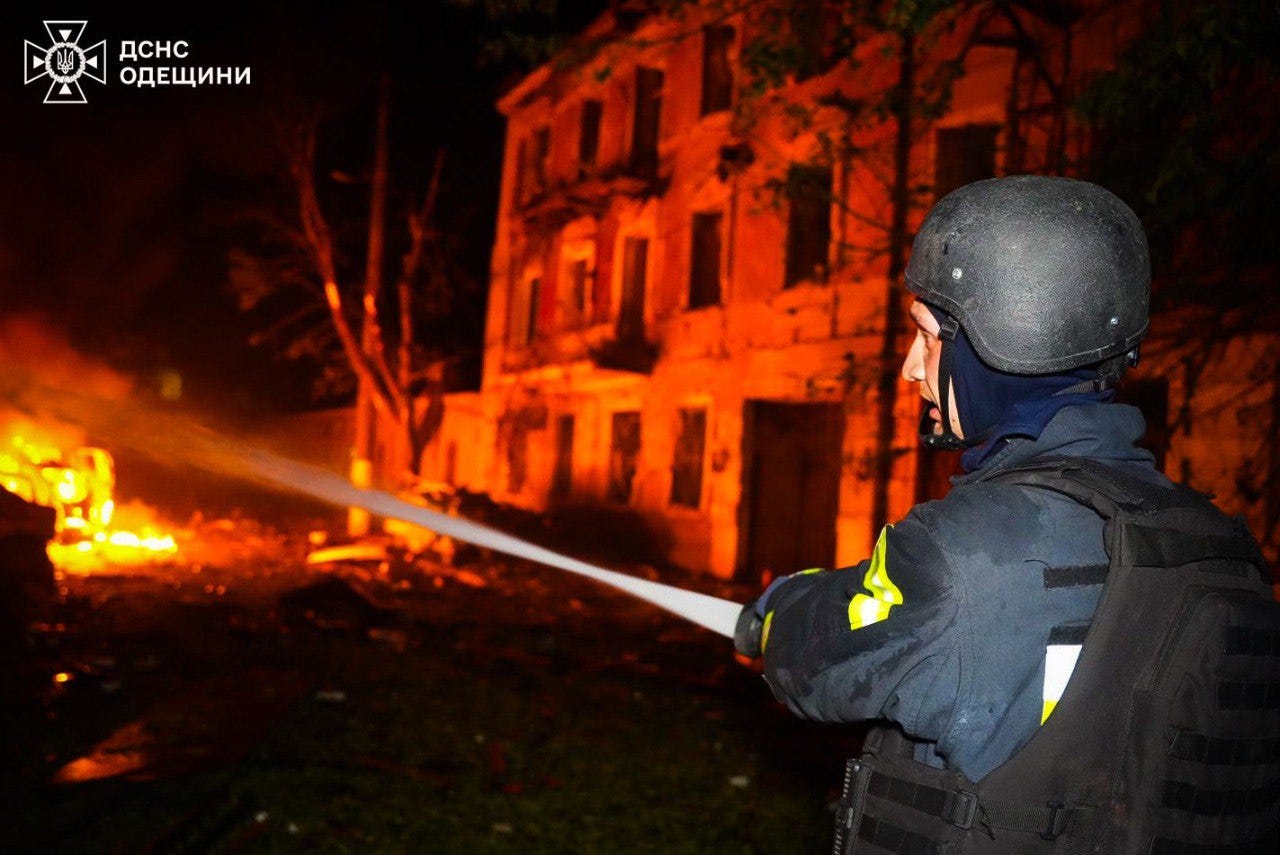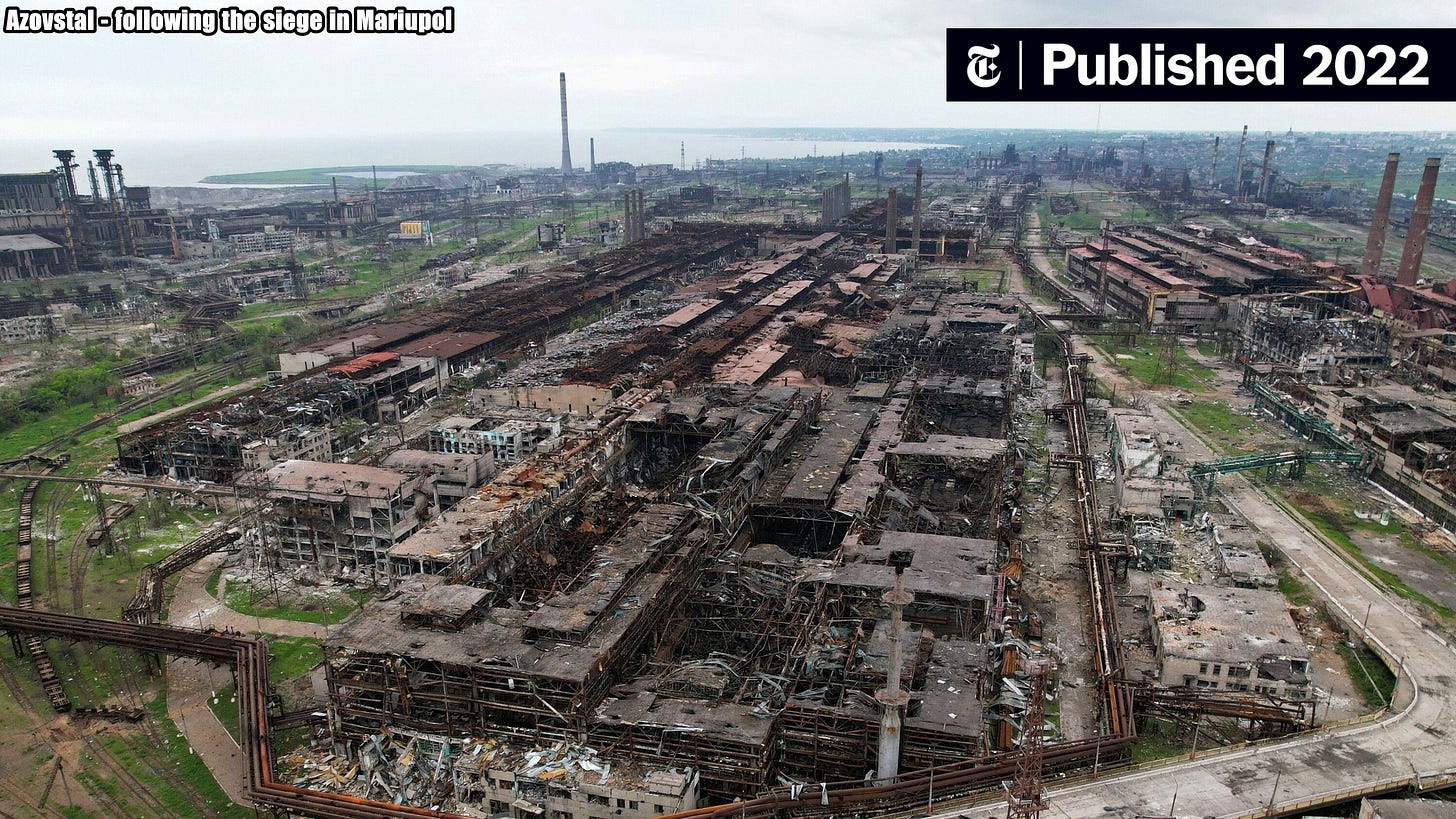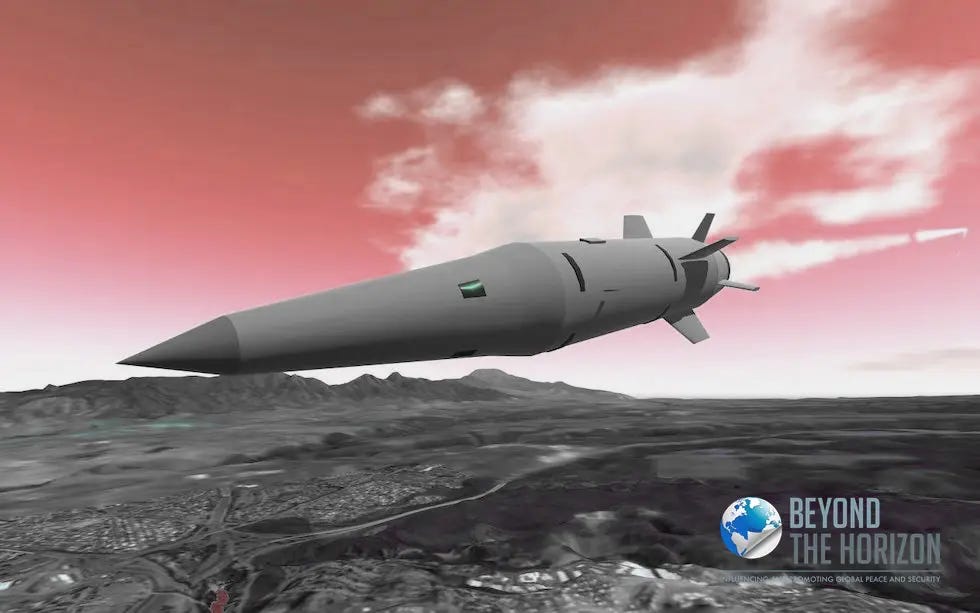Slava Ukraini! In early 2022 I began a Telegram channel aggregating news from a number of sources daily on the war in Ukraine. In June 2023 I began providing a daily draft for the Ukraine War Brief Podcast collecting news from over 70 sources daily, which formed the basis of the script. While the Podcast no longer exists I have continued to make this Brief available for my followers here on Substack for those who wish to keep up with the news from the war.
If you find the Brief informative I would appreciate it if you shared it with others.
All the latest news on the Russo-Ukraine War 6 days per week
ALONG THE CONTACT LINE
GSAFU Morning Report
For: Jun 10, 2025
The General Staff of the Armed Forces of Ukraine in its Operational Information update at 08:00 on Jun 10 stated that day 1203 of the full-scale invasion of the Russian Federation against Ukraine had begun.
The situation on the line of combat remains tense in some sectors. Ukrainian defenders continue to actively counteract the Russian aggressor, causing them significant losses in personnel, equipment and technology. Exhausting the enemy along the entire front line and continuing to disrupt the plans of Russian occupiers to advance deeper into the territory of Ukraine.
Over the past 24 hours, aviation, missile troops and artillery of the Defense Forces have hit 16 personnel and equipment concentration areas, two unmanned aircraft control points, four artillery systems and a control point of Russian invaders.
During the past day, 174 combat engagements took place.
Over the past 24 hours, the enemy carried out 22 missile strikes, 65 air strikes, used 3,391 attack drones and fired approximately 6,150 artillery shells across the positions of Ukrainian forces and civilians.
Air Force Daily Report
284 ENEMY TARGETS DISABLED
➖➖➖➖➖➖➖➖➖
On the night of June 10 (from 8:00 p.m. on June 9), the enemy attacked with 322 air attack vehicles:
- 315 Shahed attack UAVs and simulator drones of various types from the following directions: Kursk, Shatalovo, Orel, Millerovo, Primorsko-Akhtarsk – Russia;
- 2 KN-23 ballistic missiles from Voronezh region – Russia;
- 5 Iskander-K cruise missiles from Kursk region – Russia.
The main direction of the attack is the capital of Ukraine, the city of Kyiv!
The air attack was repelled by aviation, anti-aircraft missile troops, electronic warfare and unmanned systems units, and mobile fire groups of the Defense Forces of Ukraine.
According to preliminary data, as of 9:00 a.m., air defenses neutralized 284 enemy air attack vehicles, 220 were shot down by fire weapons, and 64 were lost in location:
- 213 enemy Shahed UAVs (drones of other types) were shot down by fire, 64 were lost/suppressed by electronic warfare;
- 2 KN-23 ballistic missiles;
- 5 Iskander-K cruise missiles.
Enemy airstrikes were recorded in 11 locations, and downed aircraft (fragments) fell in 16 locations.
Combat Operations in the Russian Federation
There has been no significant change in the combat environment in this sector since our last report.
The Khortytsia operational-strategic group
(Responsible for the northeastern part of Ukraine. )
Lyman Sector: Ukrainian forces recently advanced in the Lyman direction.
Geolocated footage published on Jun 8 indicates that Ukrainian forces recently advanced northeast of Karpivka (north of Lyman) and Torske (east of Lyman).
Chasiv Yar Sector: Russian forces recently advanced in the Chasiv Yar direction.
Geolocated footage published on Jun 9 indicates that Russian forces recently advanced in an industrial area northeast of Stupochky (south of Chasiv Yar).
Toretsk Sector: Russian forces recently advanced in the Toretsk direction.
Geolocated footage published on June 9 indicates that Russian forces recently advanced northwest of Toretsk.
Geolocated footage published on June 8 indicates that Russian forces recently advanced into southern Oleksandro-Kalynove (west of Toretsk), but it is unclear whether Russian forces maintain enduring positions in this area.
The Tavria operational-strategic group
(Responsible for the central-eastern and southeastern part of Ukraine.)
Novopavlivka Sector: Russian forces recently advanced in Novopavlivka direction.
The Institute for the Study of War (ISW), a US based think tank, in its Jun 9 Russian Offensive Campaign Assessment reported that Russian forces recently advanced to the Dnipropetrovsk-Donetsk administrative border as Kremlin officials continued to demonstrate that Russia has wider territorial ambitions in Ukraine beyond Luhansk, Donetsk, Zaporizhia, and Kherson oblasts and Crimea.
Geolocated footage published on Jun 9 indicates that Russian forces recently advanced to the Dnipropetrovsk-Donetsk administrative border northwest of Horikhove (southeast of Novopavlivka).
The Russian Ministry of Defense (MoD) claimed on Jun 9 that Russia's Central Grouping of Forces seized more territory in unspecified areas of Dnipropetrovsk Oblast. Russian milbloggers claimed on Jun 8 and 9 that Russian forces, including elements of the 90th Tank Division (41st Combined Arms Army [CAA], Central Military District [CMD]), are fighting near and across the Donetsk-Dnipropetrovsk Oblast border.
Kremlin Spokesperson Dmitry Peskov claimed on Jun 9 that Russia has begun an offensive into Dnipropetrovsk Oblast "within the framework of the creation of a buffer zone" in Ukraine.
First Deputy Chairperson of the Russian State Duma Defense Committee Alexei Zhuravlev claimed that Dnipropetrovsk Oblast is now within the "sphere of interests" of the Russian military.
Chairperson of the Federation Council Committee on Constitutional Legislation and State Building Andrei Klishas claimed that Russia's offensive into Dnipropetrovsk Oblast indicates the beginning of Russia's "denazification" of the oblast - a reference to Russia's longtime demand for regime change in Ukraine.
Chairperson of the Duma Defense Committee Dmitry Sablin claimed that Russia will "definitely take" Dnipro City and other unspecified Ukrainian cities if Ukraine "does not make peace on [Russia's] terms.
Russian officials are likely setting information conditions to illegally declare Dnipropetrovsk Oblast annexed, as ISW has previously assessed.
Kremlin officials have repeatedly signaled that Russia maintains territorial ambitions beyond the four oblasts that Russia has already illegally annexed, and Russian Foreign Minister Sergei Lavrov notably repeated a longstanding Kremlin claim that Odesa City is a "Russian" city as recently as Jun 9.
Ukrainian Presidential Office Deputy Head Colonel Pavlo Palisa stated on June 5 that Russia likely seeks to occupy the entirety of Ukraine on the east (left) bank of the Dnipro River, including parts of Dnipropetrovsk Oblast, and to seize Odesa and Mykolaiv oblasts by the end of 2026.
ISW continues to assess that Russia is not interested in peace negotiations with Ukraine and that Russia is preparing for a protracted war in order to make further battlefield gains
Kurakhove Sector: Russian forces recently advanced in the Kurakhove direction.
Geolocated footage published on June 9 shows elements of the Russian 114th Motorized Rifle Brigade (51st CAA, formerly 1st Donetsk People's Republic [DNR] AC, SMD) raising flags over central Oleksiivka (west of Kurakhove), indicating that Russian forces recently advanced in the area.
The Odesa operational-strategic group
(Responsible for Kherson, Qırım, (also known as Crimea) and the Black Sea.)
There has been no significant change in the combat environment in this sector since our last report.
TEMPORARILY OCCUPIED TERRITORIES
Nothing major to report.
THE HOME FRONT
In one of largest attacks on Ukraine's capital, Russian barrage hits Kyiv, Odesa, kills 3, injures 12.
Kyiv and Odesa came under another mass Russian attack in the early hours of June 10, involving ballistic missiles and drones. Explosions were heard across the capital as air defense systems engaged the targets, the Kyiv Independent reported citing local authorities.
A woman was killed and four other people were injured in Kyiv, according to local authorities. Meanwhile, in the southern city of Odesa, two men were killed and at least eight civilians were wounded in the attack. One more person suffered shock during the attack on Odesa, authorities reported.
According to President Volodymyr Zelenskyy, the attack was one of the largest on Kyiv during the full-scale war.
"Russian missile and Shahed strikes drown out the efforts of the United States and others around the world to force Russia into peace," Zelenskyy wrote on social media. "For yet another night, instead of a ceasefire, there were massive strikes with Shahed drones, cruise and ballistic missiles."
Kyiv Mayor Vitali Klitschko reported that cars were on fire in the Shevchenkivskyi district, while drone debris fell on the grounds of a school in the Obolonskyi district. Emergency services were dispatched to the sites of attack, and medics were also called to the Podilskyi and Darnytskyi districts.
Later in the day, Tymur Tkachenko, head of the Kyiv City Military Administration, said that a woman was killed in the Obolonskyi district.
In the Dniprovskyi district, smoke was seen coming from non-residential buildings, and a fire broke out at a non-residential site in the Obolonskyi district.
"A residential building is on fire in the Shevchenkivskyi district. A woman is injured and is being treated," Tkachenko said at 3:10 a.m. local time.
Klitschko added that another injured person in the Darnytskyi district was treated on the spot by medics, while the third victim was hospitalized in the Obolonskyi district of the city. Kyiv's mayor reported at 5:58 a.m. that a fourth person was hospitalized as a result of the Russian attack on the capital.
According to Culture Minister Mykola Tochytskyi, the strike also damaged St. Sophia Cathedral in Kyiv. The UNESCO World Heritage site, dating back to the 11th century, is one of Ukraine's most significant religious and cultural landmarks.
"Tonight, (Russia) struck again at the very heart of our identity," Tochytskyi wrote on Facebook. "St. Sophia Cathedral in Kyiv, a centuries-old shrine symbolizing the birth of our statehood, has been damaged."
Published footage shows what appears to be minor damage. Tochytskyi said the blast wave impacted the external part of the church's main apse.
In Odesa, a film studio and medical facilities, including a maternity hospital, were damaged.
"The administrative building of an emergency medical station was also completely destroyed. There is a fire at the scene. Ambulances are damaged. There are no injuries among the personnel," Odesa Governor Oleh Kiper said at 3:40 a.m. local time.
A Russian attack caused damage to a maternity hospital in Odesa. At the time of the attack, 85 adults and 22 children were inside, but no staff or patients were injured as everyone was in the shelter, facility director Iryna Golovatyuk-Yuzefpolskaya told Suspilne.
Odesa is located approximately 442 kilometers (274 miles) from the capital.
SES Deploys Portuguese-Transferred Ka-32 to Respond to Aftermath of Strike on Kyiv.
The State Emergency Service of Ukraine has deployed the Ka-32 helicopter, recently provided by Portugal, to help extinguish fires sparked by last night’s Russian strike on Kyiv, Militarnyi reports.
The deployment was captured in a photo shared by Radio Svoboda (Liberty – ed.) and video footage released by Suspilne.
The images show the helicopter in action, dropping water on fire hotspots using an external water release system known as a helicopter bucket.
It is a special tank used for transporting water or other fire-extinguishing agents, carried beneath the fuselage.
In September of last year, the Portuguese Ministry of National Defence announced that it had sent the first promised Ka-32 helicopters to Ukraine as part of its aid package. The helicopters were transported disassembled on trucks.
The Portuguese government announced its plans to transfer Ka-32 firefighting helicopters back in 2022, but the process was delayed due to a change in leadership. In total, Ukraine was expected to receive six multi-purpose helicopters of this type, capable of performing a wide range of missions.
The Ka-32 helicopters were purchased in 2006 by Portugal’s Ministry of Internal Administration.
This helicopter was developed in the Soviet Union based on the military Ka-27. It is designed to perform a variety of tasks, including cargo transport, rescue operations, firefighting, as well as construction and assembly work.
RUSSIAN WORLD
Russia sentences 2 Azov soldiers to over 20 years in prison.
A Russian court has sentenced two Ukrainian soldiers of the Azov Brigade to more than 20 years in prison for allegedly killing civilians in the city of Mariupol in Ukraine's Donetsk Oblast, the Kyiv Independent reported citing an announcement by Russia's Investigative Committee on Jun 9.
Russia has held a number of sham trials with Ukrainian prisoners of war (POWs) over the past years, focusing in particular on Azov soldiers captured during the war. Azov has been demonized by Russian propaganda for years.
Russian authorities accuse sniper Ruslan Orlov and paramedic Artem Novikov of shooting three civilians in Mariupol in April 2022. The Russian court sentenced Orlov to 26 years in a strict regime colony, and Novikov to 24 years.
Ukraine has not yet commented on the Russian Investigative Committee's statement.
Russia's months-long siege of Mariupol between Feb and May 2022 reduced the port city to a landscape of rubble and killed thousands.
In the meantime, the Azovstal Steel Plant in Mariupol became a symbol of Ukrainian resistance at the onset of the all-out war, as Ukrainian soldiers valiantly defended the plant under the Russian siege.
On May 16, 2022, Azovstal defenders were ordered to surrender to the encircling Russian forces after nearly two months of constant bombardment of the besieged plant.
The evacuation from Azovstal ended on May 20, 2022, with Ukrainian soldiers transferred to a penal colony in Russian-occupied Olenivka, Donetsk Oblast, now infamous as the site of the mass killing of Azov fighters.
On Jul 28, 2022 an explosion killed 54 Ukrainian prisoners of war and injured over 150 at the Olenivka penal colony. Many of them were members of Azov.
While hundreds of Azov soldiers have been released since 2022, hundreds more remain in captivity.
Armenia Is Breaking Up With Russia – And Putin Can’t Stop It.
For decades, Armenia was one of Russia’s most reliable post-Soviet allies — a small but loyal partner nestled in the volatile South Caucasus. But that marriage of convenience is now rapidly unraveling the Moscow Times reports.
Today, Yerevan is no longer whispering discontent. It is shouting it from the rooftops. And Moscow? It is scrambling to salvage the remains of its diminishing influence with soft power schemes and desperate political maneuvers.
The writing is now on the wall. Armenia is done waiting for a protector that never arrives.
The rupture can be traced most clearly to 2021 and 2022, when Azerbaijani forces launched cross-border attacks on Armenian territory and killed hundreds of Armenian soldiers. A founding member of the Russian-led Collective Security Treaty Organization (CSTO), Armenia expected solidarity. Instead, it got silence.
From Armenia’s perspective, Azerbaijan likely would not have moved on Nagorno-Karabakh if Russia had not invaded Ukraine. The war drained the Kremlin’s resources and attention, leaving a power vacuum in the South Caucasus. Baku seized the moment, knowing Russia was too distracted and weakened to respond.
CSTO's refusal to intervene shattered the illusion that Russia would uphold its end of the bargain. When Nagorno-Karabakh, a region long supported by Armenians, was blockaded and then swiftly captured by Azerbaijan in 2023, Russian peacekeepers stood idly by.
To Armenians, this was betrayal. Prime Minister Nikol Pashinyan has already suspended Armenia's participation in CSTO activities and refused to attend recent summits. Senior figures in his government said last week that Armenia will never become a full participant again and may even leave altogether.
Armenia is now rapidly shedding its long-standing dependence on Russia as its primary security guarantor and shifting toward a policy of strategic diversification.
No longer content to be a geopolitical satellite, Armenia is pursuing deeper ties with the European Union, strengthening cooperation with the United States, and seeking normalization with Turkey. This pivot is not just symbolic. It is a decisive move to anchor Armenia’s future in a multipolar world where security is not outsourced to a disinterested patron but built through balanced, pragmatic partnerships.
Senior figures from Pashinyan’s party recently confided that “Russian-backed actors trying to destabilise Armenia’s democracy.” One even quipped that the only silver lining in Armenia’s relationship with Russia is that they do not share a physical border, limiting Moscow’s direct influence.
What once might have been a subtle influence now feels like a Cold War psyop. Moscow is attempting to retake Armenia — not with tanks, but with Telegram channels, paid influencers, and geriatric loyalists.
Sergei Kiriyenko, Vladimir Putin’s First Deputy Chief of Staff, allegedly has been tasked with reviving Russian influence in Armenia ahead of the 2026 parliamentary elections.
Kiriyenko’s playbook reportedly begins with "informational work.” In other words, propaganda. Moscow is also grooming Kremlin-approved opposition figures, quietly flying them to Moscow for consultations.
But it is hard to win hearts with empty promises, especially from the country that abandoned you in war. The Armenian public, especially the youth, is more interested in visas to Paris and tech jobs in Silicon Valley than Soviet fairy tales.
Armenia is not just drifting away from Russia. It is actively building new bridges. A peace deal with Azerbaijan is inching closer, one that may finally open the closed borders with Turkey and transform Armenia from a landlocked outpost into a regional hub.
Yerevan is also deepening ties with the European Union and the United States. Armenia has welcomed a European Union civilian border mission, turning down a similar offer from Russia. This follows last year’s agreement for Russian border guards to withdraw from Zvartnots Airport in Yerevan and key border areas near Azerbaijan, highlighting Armenia’s move away from Moscow’s direct control.
European aid, investment and security dialogue are expanding while American diplomats are visiting more frequently. In April 2024, the U.S. and Armenia launched a new Strategic Dialogue focused on democratic reforms and security cooperation. These are not just diplomatic niceties; they are lifelines.
Armenia understands that its future lies not in the shadow of a declining empire but among liberal democracies that value sovereignty and partnership.
Investigation Uncovers Telegram's Links to Russia's FSB.
The Telegram messaging app may be less secure than previously thought, as its infrastructure is controlled by a man whose companies have collaborated with Russian intelligence services, according to a new investigation by the exiled outlet IStories.
The popular messaging app's founder, Russian-born Pavel Durov, has touted his platform as a haven for free speech and digital privacy, particularly in authoritarian countries.
In reality, Telegram chats are not end-to-end encrypted by default like competitors WhatsApp or Signal. Unless users opt in to the app’s "secret chat" feature, these chats are decrypted and stored on servers.
"This means that whoever controls the server can access the correspondence," IStories wrote.
This infrastructure is maintained by Global Network Management (GNM), a little-known company based in Antigua and Barbuda that has provided Telegram with over 10,000 IP addresses, IStories found.
GNM’s owner, Russian national Vladimir Vedeneev, testified in a U.S. court that the company installs and maintains Telegram’s infrastructure and has staff in Russia. According to court documents reviewed by IStories, Vedeneev also serves as Telegram’s chief financial officer.
Many of GNM’s IP addresses previously belonged to St. Petersburg-based telecommunications firm Globalnet, which has links to the Kremlin and Russian intelligence services, including the FSB, IStories reported.
Telegram also reportedly received 5,000 IP addresses from another St. Petersburg-based company, Electrontelecom, which IStories identified as an FSB contractor. The company provided installation and maintenance for secure communication systems used in intelligence operations.
In 2022, Globalnet implemented user traffic monitoring systems at the request of the Russian state communications watchdog Roskomnadzor.
Oleg Matveychev, deputy chairman of the State Duma’s Information Policy Committee, said at the time that Telegram and the FSB had reached a “compromise” in which Telegram installed infrastructure enabling authorities to monitor users involved in criminal investigations, such as suspected terrorists.
In addition to decrypting its users’ messages and storing them on servers, Telegram also attaches a unique device identifier known as auth_key_id to every message, cybersecurity expert Michał Woźniak told IStories.
This identifier allows the platform to determine the user’s device and apply the appropriate decryption key. In combination with metadata like IP addresses and timestamps, Woźniak said, this system could be used to determine a user’s physical location and contacts.
“If someone has access to Telegram traffic and cooperates with Russian intelligence services, this means that the device identifier becomes a really big problem — a tool for global surveillance of messenger users, regardless of where they are and what server they connect to,” Woźniak told IStories.
Telegram founder Pavel Durov did not respond to IStories' requests for comment.
RELATED INTERNATIONAL NEWS
US accuses Russian of laundering millions, helping Moscow obtain sensitive technology.
U.S. prosecutors have charged cryptocurrency entrepreneur Iurii Gugnin with laundering over $500 million and helping sanctioned Russian entities bypass export controls. The US Dept of Justice reported.
Gugnin, a 38-year-old Russian national living in New York, founded the U.S.-based companies Evita Investments and Evita Pay. He was arrested in New York on Jun 9 and faces multiple charges, including wire fraud, bank fraud, money laundering, and conspiracy.
According to court documents, Gugnin used his crypto payments companies to receive cryptocurrency from foreign clients, many of whom held accounts at sanctioned Russian banks. He then converted the funds into U.S. dollars through U.S. bank accounts and facilitated payments for electronics and other goods, concealing the origin of the money and the identities of those involved.
"Gugnin’s cryptocurrency company allegedly served as a front to launder hundreds of millions of dollars for sanctioned Russian entities and to obtain export-controlled technology for the Russian government," said Assistant Director Roman Rozhavsky of the FBI’s Counterintelligence Division.
Between June 2023 and January 2025, Gugnin used Evita to facilitate the movement of approximately $530 million through the U.S. financial system, most of which he received in the form of a cryptocurrency stablecoin known as Tether, according to the U.S. Department of Justice report.
Prosecutors allege that Gugnin laundered money used to purchase parts for Rosatom, Russia’s state-owned nuclear technology company, and helped Russian end-users acquire export-controlled U.S. technology. Assistant Attorney General John A. Eisenberg said Gugnin turned a crypto startup into “a covert pipeline for dirty money.”
The Department of Justice accused Gugnin of deceiving banks and crypto exchanges by falsely claiming that Evita did not deal with Russian or sanctioned entities. He also allegedly doctored invoices to obscure Russian customers and failed to comply with anti-money laundering rules, including neglecting to file required suspicious activity reports.
If convicted, Gugnin faces a maximum penalty of 30 years in prison for each count of bank fraud and a maximum penalty of 20 years in prison for each of the wire fraud.
Israel issues conflicting claims regarding Patriot systems allegedly shipped to Ukraine.
Israel has not transferred any Patriot air defense systems to Ukraine, the Israeli Foreign Ministry informed Israeli news outlet Ynet on June 10, refuting earlier claims made by its own ambassador in Kyiv.
"Israel has not transferred such systems to Ukraine," the Israeli Foreign Ministry told Ynet in a statement.
The denial contrasts with statements made by Israeli Ambassador to Ukraine Michael Brodsky, who said in a recent interview that Israel had agreed to transfer retired Patriot missile systems — originally supplied by the U.S. in the 1990s — to Ukraine.
"The Patriot systems that we once received from the United States are now in Ukraine," Brodsky said in an interview with Ukrainian blogger Marichka Dovbenko. "When people say that Israel did not help militarily, that is not true."
Brodsky made the claim in an interview with Ukrainian blogger Marichka Dovbenko, saying the Patriot air defense systems sent to Ukraine had originally come from the United States in the early 1990s. His comments appeared to mark the first public Israeli acknowledgment of direct military aid to Ukraine.
Kyiv has consistently pressed Western partners to bolster Ukraine's air defenses, warning that its current capabilities are insufficient to counter the scale of Russian missile and drone assaults.
The Patriot system, a U.S.-made surface-to-air missile platform, is widely recognized for its high-precision detection, tracking, and interception of aircraft, cruise, and ballistic missiles.
Ukrainian Foreign Ministry spokesperson Heorhii Tykhyi has neither confirmed nor denied the delivery of Israeli Patriots to Ukraine.
"We welcome signals from Israel about its readiness to provide military assistance," Tykhyi said at a press briefing.
MILITARY & TECH
Russia Can’t Replace Lost MiG-31Ks: Every Loss of Kinzhal Carrier Hits Hard.
The General Staff of the Armed Forces of Ukraine, announced that on the night of Jun 9, Ukrainian special operations forces, in cooperation with other branches of the Defense Forces, struck the Savasleyka airfield and damaged at least one MiG-31 and one Su-30 or Su-34. Defense Express reports.
Russia is currently unable to produce new MiG-31K aircraft capable of carrying the Kinzhal hypersonic missile. This makes the loss of any such aircraft especially painful for the Kremlin.
Since the beginning of the full-scale invasion, Russia has tried to expand its MiG-31K fleet. While it reportedly had around 12 of these aircraft at the start of 2022, The Military Balance 2024 suggests the number may have grown to as many as 24.
Additionally, Russia has introduced the MiG-31I (where I stands for Ishim) which reportedly differs from the MiG-31K by its ability to automatically reach the launch point for the Kh-47M2 Kinzhal missile. In contrast, the MiG-31K relies on manual operation by its two-person crew.
Russia may have attempted to increase the fleet of MiG-31K and MiG-31I aircraft by reactivating airframes from storage. As of 2018, there were an estimated 130 to 150 MiG-31s in reserve. However, these stored aircraft most likely served as a source of spare parts to keep the MiG-31B/BM interceptor fleet operational. As of early 2024, approximately 90 interceptors remained in service with the Russian Aerospace Forces and another 30 with Russian naval aviation.
Serial production of the MiG-31 ended in 1993, with around 500 aircraft built. Today, only about 150 remain in active service. This highlights both the aircraft’s limited service life and the challenges of maintaining such an old platform under Russian conditions.
Another critical issue is the D-30F6 engine used by the MiG-31. Its overhaul life is just 300 hours. Although in 2014 Russian officials claimed they had a stockpile of engines sufficient for 20 to 30 years, by 2024 they began discussing the need to resume production of the engine altogether.
According to current data from Ukraine’s Defense Intelligence, Russia’s defense industry produces approximately 10 to 15 Kinzhal missiles per month and has a stockpile of around 100 missiles.
That’s it for today’s Brief folks if you would like to keep up with events in Ukraine daily please consider subscribing, it’s free!







